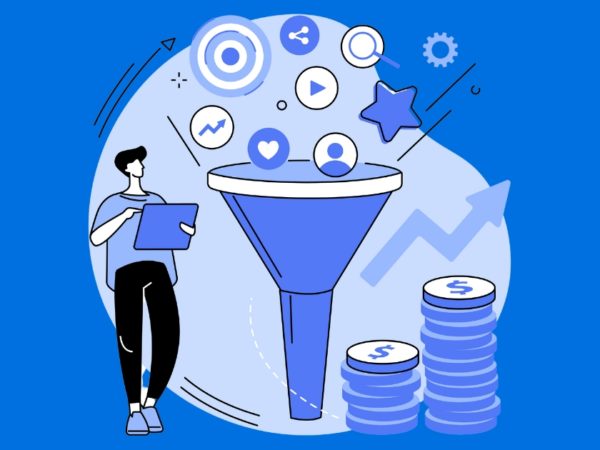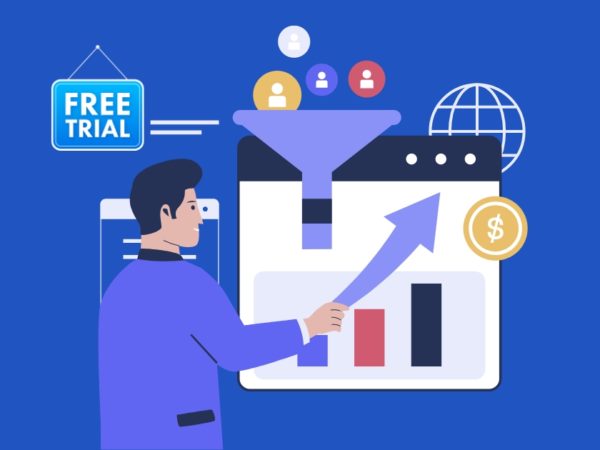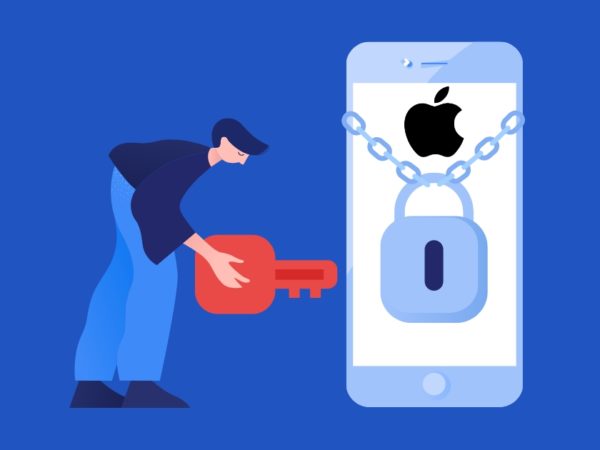Deep linking is an advanced app content or resource delivery system where you can take the target audience directly to the app page where you exactly want them. It enhances your marketing efforts for apps and products a lot!
As a mobile app marketer, you may have used hundreds of tools to increase the outreach of your app. Your day-to-day target is to create brand awareness for the products and services of the app.
Most of the marketing tools for the above cause just inform the customers, prospects, and target audience of your app or brand. Customers take the next step from there. It is a passive way of pushing to customer or user to act.
Hence, these are not efficient enough. You need something proactive to take the customers directly to the app page or a feature that impacts your app’s downloads, installations, revenue, etc. You can achieve this using a mobile app deep linking system.
Read on to develop a foundation-level knowledge of deep linking so that you can also implement this outstanding marketing tool to good use.
What Is Deep Linking?
In the mobile app ecosystem, deep linking is the way to guide your customers and users to a specific page, feature, product, service, cart, and anything else on the mobile app.
By using the deep unified resource identifiers (URIs), users can land directly on the content in the mobile app you are suggesting.
The users do not need to go through several steps to arrive at their point of interest. Also, such links bypass all logins and signups in special cases if the user has installed and used the app before or you customize the deep linking system with sufficient authentication protocols.
This is the “Destination” part of deep linking. You must also decide how to give your target audience access to such links. It’s the “Source” part of deep URIs. Set up of the Source is quite easy. You can create a deep link and then place it strategically using the following content-sharing techniques:
- Share deep URLs via SMS, and its industry term is text-to-app
- Send a deep link to app content via email, aka email-to-app
- You can also place deep linking URIs on web pages, and that creates the web-to-app concept
- Some marketers create QR codes (QR-to-app) using QR code generators and paste QR code stickers on objects, shops, or digital QR codes on websites so that the users can scan and access deep links
- You can also post social media statuses, comments, and images with deep links to use the social-to-app deep linking model
- Some app marketers also place deep URIs in referral links for referral-to-app deep links
- Place deep links on ads like Google Ads banners, called ad-to-app.
Benefits of Deep Linking
Marketers use deep linking primarily to create intuitive content delivery experiences. It helps to drive downloads, installations, subscriptions, purchases, etc., by taking customers to the activity page of the app instantly.
Instead of texting your customers the steps from downloading an app to product purchasing, you directly add the product to the cart and show them the checkout screen.
For services, you directly push the subscription payment page. Also, to ask customers to try out the latest feature on your app, you send them to the app screen where the feature is available.
Find below some additional benefits your app marketing campaigns enjoy from the deep linking technique:
#1. Enhance Conversions
Deep linking boosts sales through your app. If you’re offering customers any discount or promotional prices and sending a text with the code, chances are the user might ignore it. Sometimes, they try to use the coupon but can not make it all the way to the checkout page.
Instead, sending a deep link to the product cart along with an embedded coupon code will take the buyer directly to a checkout page that shows the best price. It is highly likely the user will act on it.
#2. Strengthen Customer Experience
Deep links from several channels, like QR codes, SMSs, emails, etc., enhance the customer experience of the app in question. However, if the link is broken, then you might lose trust.
#3. Retain Users and Customers
Various marketing teams have used the deep linking tool for customer and user retention. You can automate your app with built-in logic to send users deep links if the app sees the user is deleting their account, abandoning carts, not renewing subscriptions, and so on.
#4. Customer Support
Deep URIs are great tools for customer service teams. Instead of guiding the user step-by-step to issue troubleshooting, you can send them a deep link that will directly take the customer to app settings, permissions, or other pages where they can fix an ongoing issue themselves.
#5. Make Users Engage With Your Brand
Marketers send SMSs, WhatsApp text, emails, and more with deep links to make the users do things the marketers want while staying within the ethical and compliance policies.
For example, you are seeing that your app’s ratings and rankings are not increasing at all. What you can do is send an SMS or WhatsApp text to users who did not submit a rating yet. Here, instead of asking them to rate, you take them directly to the Google Play page, where they can quickly rate the app.
Marketers have also discovered that strategically placed deep links increase the number of paid users of your app.
#7. Boost Click-to-Install Rates
The click-to-install rates for any advertising campaign also increase sharply when you use deep linking on Google, Bing, Facebook, and Twitter ads.
Types of Deep Linking
There are different types of deep linking concepts, and these are as outlined below:
Universal Linking
Apple uses the Universal Linking system for all its devices like iPad, iPhone, iPod, Mac, etc. If you send a deep link to a user, you need to follow the Universal Linking protocol on iOS and iPadOS ecosystems.
When the user taps this link, the designated app will open on iPhone or iPad. If the app isn’t installed, then the link will redirect the user to your website or source from which the user accessed the deep link.
You can also modify the universal link in a way to redirect the user to App Store for app download and installation because universal links enable you to open a web page from an app. Apple introduced Universal Linking as deep linking on its operating systems since iOS 9.
The iOS operating system directly handles commands of all Universal Linking requests. Hence, Universal Linking is more secure than conventional deep links.
App Links
Android App Links is a deep linking protocol for the website to mobile app redirects on Android devices like smartphones and tablets. App Links use HTTP URLs to take users directly to a mobile app screen, feature, or content from a website.
If there is no installed version of the said app, the HTTP code will try to take the user to a copy of the same content on the website of the app. If the content isn’t available on the website, then it takes the user to the source of the App Link.
App Link supports Google Ads products like Display, Search, Shopping, App engagement campaigns, and more.
Deferred Deep Linking
Deferred deep linking is essentially two redirects. It uses mobile attribution technology and content link memories. It takes the user to one page to perform some tasks and then takes them back to the source of the deep link to get the original link that redirects the users to content in the mobile app.
It is the most dependable deep linking variant for online advertisers to target users who have not installed the app yet.
Once the user clicks on the link, the first action is opening the download button on the Google Play or App Store app on the mobile phone for the app being marketed. Once the user installs the app, the link redirects again to content or feature in the app.
Contextual Deep Linking
Contextual deep links take deep linking systems to the next level by offering highly customizable and relatable experiences to the customer.
You can deploy such links along with a specialized landing page on the app with a welcome greeting and one-time promo code or discount only available to the current user. It also fetches various deep linking metrics data like ad campaign performance, clicks, return on investment (ROI), etc.
What Are URI Schemes in Deep Linking?
Uniform Resource Identifier or URI is a sequence of characters that points networked and not networked devices to physical or logical resources. URI is similar to URL. However, URL is only used in the case of internet and intranet protocols. Whereas URI can be used for both online and offline resource identification.
The format of creating or writing a URI address is known as URI schemes. The components of URI schemes are scheme name (a domain, drive, app data, etc.), authorization, query, and fragment.
In the case of web-to-mobile redirects, URI schemes are the components of deep linking. For example, twitter://, facebook://, netflix://, etc., are URI schemes. Deep links use these URI schemes to open the related app on smartphones and tablets. These are also some sort of custom deep links.
URI schemes interact with the app data on the device. Hence, if an app is unavailable on the target device, then URI schemes will return an error message.
How to Implement Deep Linking
You can use a Mobile Deep Linking library to create your deep links for iOS or Android apps. Whether you use such tools or not, you must do the following to implement deep linking:
#1. Selecting a Unique URI Scheme
You must select a URI scheme before you can create a deep link. The URI scheme must be unique. Otherwise, your deep link may open your competitor’s app and show an error thereon. Once you have created a URI schema, submit the URI details to the app manifest.
#2. Define Deep Link Actions
Once the URI scheme is ready, choose a set of actions for the link it will perform when the user taps on it.
Provided that you have completed the above two steps, now you can compile all the above in a URI scheme code. Now, embed the code in various delivery systems like WhatsApp, SMS, QR codes, websites, etc.
You must also activate deep linking in your app. For Android apps, go to Test your Android App Links, and for Apple devices, get Apple’s App Search API Validation Tool.
Examples of Deep Linking
#1. Deep Linking for Referrals and User Acquisition
Gaming and messaging apps often use deep links to acquire new users and let them experience the app immediately to retain them.
For example, a referral deep link takes users directly to the game app events right after the downloading, installing, and signing up actions.
#2. Manage Cart Abandonment Instances
Users can abandon a cart for many reasons, like losing the checkout page due to a notification pop-up or a problem with the payment method. eCommerce and digital retail businesses use deep links to guide users to forgotten carts.
#3. Banking Process Abandonment Handling
Banking, insurance, and investment niches use deep links to revive a new customer boarding process. If customers leave a signup or application form, the deep links will show up via Google Ads and other forms as banners. When users click it, they directly go to the form field from where they abandoned the process.
Some other popular deep-linking examples are:
- Sending promotions and discounts
- Introducing new app features
- Offer personalized content
- Promote news and trending content
- Sending viral videos and memes
- Offering personalized customer or user onboarding journeys
When to Avoid Deep Links
The developers, marketers, and users must stop using deep links in insecure networks. Also, the user should not tap on any deep links if they suspect someone has hacked the device.
Deep links transmit secured data between the app server and the mobile device. Hence, hackers can use app impersonation, social engineering, and phishing to push the user to download a fake app. Then, the attackers can steal data and exfiltrate data without even users knowing this.
Final Words
If you know how to develop and implement a deep linking system for your mobile app, you can achieve maximum marketing goals with minimum investment.
Users also love this approach since it is intuitive to access promoted app features, content, products, discounts, and more.
All you need to do, as a smart app marketer, is to use the deep linking system strategically to enjoy the maximum benefits of this marketing technique.
Next, check out the best App Store Optimization (ASO) tools.



